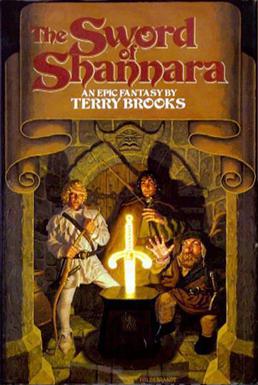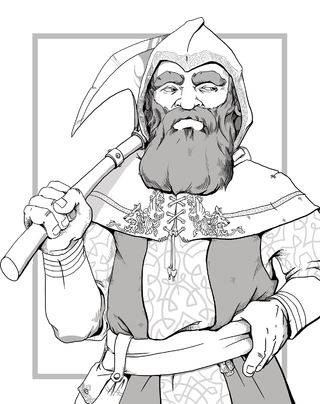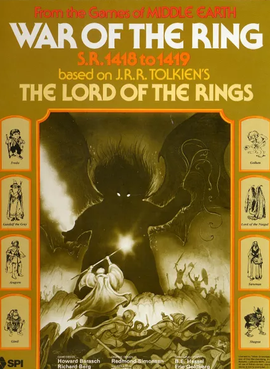Related Research Articles
The Rings of Power are magical artefacts in J. R. R. Tolkien's legendarium, most prominently in his high fantasy novel The Lord of the Rings. The One Ring first appeared as a plot device, a magic ring in Tolkien's children's fantasy novel, The Hobbit; Tolkien later gave it a backstory and much greater power. He added nineteen other Great Rings, also conferring powers such as invisibility, that it could control, including the Three Rings of the Elves, Seven Rings for the Dwarves, and Nine for Men. He stated that there were in addition many lesser rings with minor powers. A key story element in The Lord of the Rings is the addictive power of the One Ring, made secretly by the Dark Lord Sauron; the Nine Rings enslave their bearers as the Nazgûl (Ringwraiths), Sauron's most deadly servants.
A Balrog is a powerful demonic monster in J. R. R. Tolkien's Middle-earth. One first appeared in print in his high-fantasy novel The Lord of the Rings, where the Fellowship of the Ring encounter a Balrog known as Durin's Bane in the Mines of Moria. Balrogs appear also in Tolkien's The Silmarillion and his legendarium. Balrogs are tall and menacing beings who can shroud themselves in fire, darkness, and shadow. They are armed with fiery whips "of many thongs", and occasionally use long swords.
Mithril is a fictional metal found in J. R. R. Tolkien's Middle-earth writings. It is described as resembling silver, but being stronger and lighter than steel. It was used to make armour, such as the helmets of the citadel guard of Minas Tirith, and ithildin alloy, used to decorate gateways with writing visible only by starlight or moonlight. Always extremely valuable, by the end of the Third Age it was beyond price, and only a few artefacts made of it remained in use.
The Dark Eye is a German tabletop role-playing game with a high fantasy theme created by Ulrich Kiesow and launched by Schmidt Spiel & Freizeit GmbH and Droemer Knaur Verlag in 1984. It is the most successful role-playing game on the German market, outselling Dungeons & Dragons. Many years of work on the game have led to a detailed and extensively described game world.
Hârn is a campaign setting for fantasy role-playing games, designed by N. Robin Crossby, and published by Columbia Games in 1983.

The Sword of Shannara is a 1977 epic fantasy novel by American writer Terry Brooks. It is the first book in a titular trilogy.

A Fantasy trope is a specific type of literary tropes that occurs in fantasy fiction. Worldbuilding, plot, and characterization have many common conventions, many of them having ultimately originated in myth and folklore. J. R. R. Tolkien's legendarium for example, was inspired from a variety of different sources including Germanic, Finnish, Greek, Celtic and Slavic myths. Literary fantasy works operate using these tropes, while others use them in a revisionist manner, making the tropes over for various reasons such as for comic effect, and to create something fresh.

A magic item is any object that has magical powers inherent in it. These may act on their own or be the tools of the person or being whose hands they fall into. Magic items are commonly found in both folklore and modern fantasy. Their fictional appearance is as old as the Iliad in which Aphrodite's magical girdle is used by Hera as a love charm.

A dwarf, in the Dungeons & Dragons (D&D) fantasy roleplaying game, is a humanoid race, one of the primary races available for player characters. The idea for the D&D dwarf comes from the dwarves of European mythologies and J. R. R. Tolkien's novel The Lord of the Rings (1954-1955), and has been used in D&D and its predecessor Chainmail since the early 1970s. Variations from the standard dwarf archetype of a short and stout demihuman are commonly called subraces, of which there are more than a dozen across many different rule sets and campaign settings.

Dračí doupě is a popular Czech role-playing game, very loosely based on Dungeons & Dragons. It was created by the publishing company ALTAR.
The fictional races and peoples that appear in J. R. R. Tolkien's fantasy world of Middle-earth include the seven listed in Appendix F of The Lord of the Rings: Elves, Men, Dwarves, Hobbits, Ents, Orcs and Trolls, as well as spirits such as the Valar and Maiar. Other beings of Middle-earth are of unclear nature such as Tom Bombadil and his wife Goldberry.

The elf is a humanoid race in the Dungeons & Dragons fantasy role-playing game, one of the primary races available for player characters, and play a central role in the narratives of many setting worlds of the game. Elves are described as renowned for their grace and mastery of magic and weapons such as the bow and sword. Becoming physically mature by the age of 25 and emotionally mature at around 125, they are also famously long-lived, capable of living more than half a millennium and remaining physically youthful. Possessed of innate beauty and easy gracefulness, they are viewed as both wondrous and haughty by other races in-universe; however, their natural detachment is seen by some as introversion or xenophobia. They were usually portrayed as antagonistic towards dwarves.

In the Dungeons & Dragons role-playing game, orcs are a primitive race of savage, bestial, barbaric humanoid.
Magic in Middle-earth is the use of supernatural power in J. R. R. Tolkien's fictional Middle-earth. Tolkien distinguishes ordinary magic from witchcraft, the latter always deceptive, stating that either type could be used for good or evil.
The Maiar are a fictional class of beings from J. R. R. Tolkien's high fantasy legendarium. Supernatural and angelic, they are "lesser Ainur" who entered the cosmos of Eä in the beginning of time. The name Maiar is in the Quenya tongue from the Elvish root maya- "excellent, admirable".

Middle-earth is the setting of much of the English writer J. R. R. Tolkien's fantasy. The term is equivalent to the Miðgarðr of Norse mythology and Middangeard in Old English works, including Beowulf. Middle-earth is the human-inhabited world, that is, the central continent of the Earth, in Tolkien's imagined mythological past. Tolkien's most widely read works, The Hobbit and The Lord of the Rings, are set entirely in Middle-earth. "Middle-earth" has also become a short-hand term for Tolkien's legendarium, his large body of fantasy writings, and for the entirety of his fictional world.
In the fictional world of J. R. R. Tolkien, Moria, also named Khazad-dûm, is an ancient subterranean complex in Middle-earth, comprising a vast labyrinthine network of tunnels, chambers, mines and halls under the Misty Mountains, with doors on both the western and the eastern sides of the mountain range. Moria is introduced in Tolkien's novel The Hobbit, and is a major scene of action in The Lord of the Rings.

War of the Ring, subtitled "S.R. 1418 to 1419", is a licensed wargame published by Simulations Publications, Inc. (SPI) in 1977 that simulates the events described in The Lord of the Rings by J.R.R. Tolkien.

Sauron, subtitled "The Battle for the Ring, S.A. 3434", is a licensed board wargame published by Simulations Publications, Inc. (SPI) in 1977 that simulates the battle between Sauron and the Last Alliance of Elves and Men mentioned in the fantasy novel The Lord of the Rings by J.R.R. Tolkien.

J. R. R. Tolkien, a devout Roman Catholic, created what he came to feel was a dilemma for himself with his supposedly evil Middle-earth peoples like Orcs, when he made them able to speak, so they were sentient and sapient, and portrayed them talking about right and wrong. This meant, he believed, that they were open to morality, like Men. In Tolkien's Christian framework, that in turn meant they must have souls, so killing them would be wrong without very good reason. Orcs serve as the principal forces of the enemy in The Lord of the Rings, where they are slaughtered in large numbers in the battles of Helm's Deep and the Pelennor Fields in particular.
References
- 1 2 Campbell, Bruce (May–June 1980). "Capsule Reviews". The Space Gamer . Steve Jackson Games (28): 26.
- 1 2 3 4 Watson, Tony (August 1980). "The Dragon's Augury". Dragon . TSR, Inc. (40): 59.
- ↑ Lambshead, John (April–May 1980). "Open Box". White Dwarf . Games Workshop (18): 13.
- ↑ Ladyman, David (July 1981). "Capsule Reviews". The Space Gamer . Steve Jackson Games (41): 30.
- ↑ "Vintage Treasures: Swordquest, by Task Force Games – Black Gate".
- ↑ https://archive.org/details/Fantastic_v27n11_1980-10/page/n21/mode/2up
- ↑ https://archive.org/details/dungeoneer17/dungeoneer_17/page/10/mode/2up